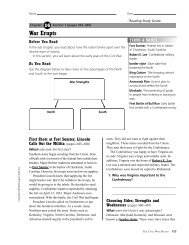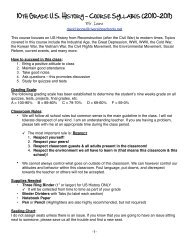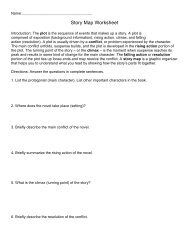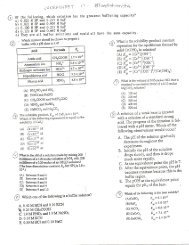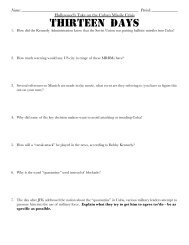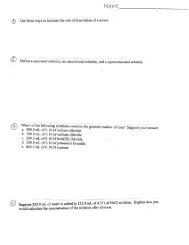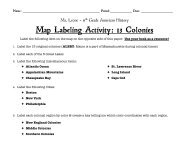Chapter 16 Text
Chapter 16 Text
Chapter 16 Text
You also want an ePaper? Increase the reach of your titles
YUMPU automatically turns print PDFs into web optimized ePapers that Google loves.
<strong>16</strong>.6 Weak Acids 627<br />
Solve: (a) NaOH dissociates in water to give one OH ion per formula unit. Therefore,<br />
the OH~ concentration for the solution in (a) equals the stated concentration of NaOH,<br />
namely 0.028 M.<br />
Method 1:<br />
_ 1-0 X IP"14<br />
[H ] ~ 0.028<br />
Method 2:<br />
= 3.57 x 10~53 M pH - -log{3.57 x lO"13) = 12.45<br />
pOH = -log(0.028) = 1.55 pH - 14.00 - pOH = 12.45<br />
(b) Ca(OH)2 is a strong base that dissociates in water to give two OH~ ions per<br />
formula unit. Thus, the concentration of OH~(aq) for the solution in part (b) is<br />
2 X (0.0011 M) - 0.0022 M.<br />
Method 1:<br />
1 n v<br />
[H+]-<br />
0.0022<br />
= 4.55 X ID"12 M<br />
Method 2:<br />
pOH = -log(0.0022) - 2.66<br />
pH = -log(4.55 x 10~12) = 11.34<br />
pH = 14.00 - pOH = 11.34<br />
PRACTICE EXERCISE<br />
What is the concentration of a solution of (a) KOH for which the pH is 11 .f<br />
(b) Ca(OH)2 for which the pH is 11.68?<br />
Answers: (a) 7.8 X 10~3 M; (b) 2.4 X 10"3 M<br />
Although all the hydroxides of the alkali metals (group 1A) are strong electrolytes,<br />
LiOH, RbOH, and CsOH are not commonly encountered in the laboratory.<br />
The hydroxides of the heavier alkaline earth metals, Ca(OH)2, Sr(OH)2,<br />
and Ba(OH)2 , are also strong electrolytes. They have limited solubilities, however,<br />
so they are used only when high solubility is not critical.<br />
Strongly basic solutions are also created by certain substances that react with<br />
water to form OH~(aq). The most common of these contain the oxide ion. Ionic<br />
metal oxides, especially Na2O and CaO, are often used in industry when a strong<br />
base is needed. Each mole of O2~ reacts with water to form 2 mol of OH~, leaving<br />
virtually no O2~ remaining in the solution:<br />
O2-(aq) + H2O(0 - > 2OH~(aq) J [<strong>16</strong>.22]<br />
Thus, a solution formed by dissolving 0.010 rnol of Na2O(s) inienough water to<br />
form 1.0 L of solution will have [OH~] = 0.020 M and a pH of 12.30.<br />
Ionic hydrides and nitrides also react with H2O to form OH~:<br />
H2O(0 - > H2(g) + OrT^) [<strong>16</strong>.23]<br />
3H2O(/) - > NH3(oj) + 3OH~(aq) [<strong>16</strong>.24]<br />
Because the anions O2~, H~, and N3~ are stronger bases than OH~ (the conjugate<br />
base of H2O), they are able to remove a proton from H2O.<br />
<strong>16</strong>.6 Weak Acids _<br />
Most acidic substances are weak acids and are therefore only partially ionized in<br />
aqueous solution. We can use the equilibrium constant for the ionization reaction<br />
to express the extent to which a weak acid ionizes. If we represent a general weak<br />
acid as HA, we can write the equation for its ionization reaction in either of the<br />
following ways, depending on whether the hydrated proton is represented as<br />
or<br />
or<br />
H2O(/)<br />
HA(aiy)<br />
[<strong>16</strong>.25]<br />
[<strong>16</strong>.26]<br />
Students often confuse a weak add<br />
(small Ka) with a dilute add (low<br />
concentration).<br />
|ohn J. Fortman, "Pictorial Analogies<br />
XI: Concentrations and Acidity of<br />
Solutions," /. Chem. Educ., Vol. 71,<br />
1994,430^32-<br />
Todd P. Silverstein, "Weak vs Strong<br />
Acids and Bases: The Football<br />
Analogy," \ Chem. Educ, Vol. 77,<br />
2000, 849-850.



